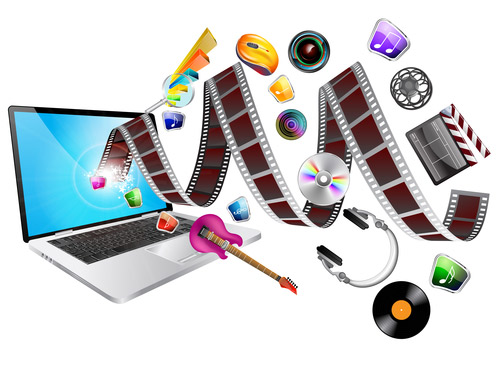The History of Multimedia: Past, Present, and Future
Today multimedia might be defined as the seamless digital integration of text, graphics, animation, audio, still images and motion video in a way that provides individual users with high levels of control and interaction. The evolution of Multimedia is a story of the emergence and convergence of these technologies.

As these technologies developed along separate paths for disparate purposes, visionaries saw the possibilities for the sum of the parts as well potential personal application in the broader societal context..
The word multimedia is used to describe computer related experiences that combine several communications media such as audio, video, text, etc. It has become a buzzword for computer interactive and general computer environments. But multimedia is not, of course, something that has been invented by and for computer users. Life itself is a multimedia experience of the five senses – sound, sight, touch, taste, and smell – which every one of us experiences every minute of the day, whether we are walking to work or cooking dinner.

The multimedia experience in the virtual world of the computer is an attempt to better mimic life experiences. It’s a digital A/V environment on the desktop, over local and global networks, so far limited to audio and video – sound and sight. The term multimedia describes a common vision for the direction of audio visual communication and interactivity.
Multimedia refers not only to different media types stored as digital data, but to highly structured databases which can be accessed by users with a high level of interactivity and content control. The user ideally controls content, making him a creator rather than just a viewer. The content should have an intellectual or entertainment value that stimulates the user into an inter “Every road in life is a journey. The rear view mirror is to remind us of where we have been so that we can fully understand where we are going”active involvement. By accessing databases, the user can grab video, text, audio, and images, to create self-authored content or interactive applications.

The movie and video industry will soon make the transition to completely digital format where the film camera is replaced with a higher resolution digital camera that will record data at a fraction of the cost of 72mm film. Digital storage, i.e. hard drives, proprietary laser discs, etc., are now being developed to contain and record large amounts of high resolution video data. Storage is one of the only hurdles in the complete transition to digital film making. Just ten years ago, 256 kilobytes of data was huge. In the digital imaging world of the nineties, two gigabytes is laughably small. In what follows, video storage will be discussed in more depth. Technology is rapidly evolving and storing 1000 gigabytes quickly and without error, will be the answer to the new wave of filmmakers.
Hard drive technology is the key to digital cinema. Large storage capacities, high data transfer rates and miniature mechanics will allow filmmakers to capture moving images digitally and inexpensively, with no quality loss. The idea that a special hard drive may be required for digital video probably began with Avid Technology, which learned early on that not dropping video frames was critical to video editing. New types of CDs are now being produced by Toshiba Corp. and Time Warner. They propose a ‘Digital Compact Disc’ (DCD – otherwise referred to as DVD) that is actually two thin plastic discs sandwiched back to back. Each side would store 5 Gigabytes, for a total of 10GB, although users will have to flip the disc over to access the opposite side. Matsushita, Hitachi, Pioneer, Thompson, Mitsubishi, Toshiba, and Victor (JVC brand) are expected to license the technology and ramp up to manufacture DCD drives and discs. Recently, Matsushita announced a 9GB version of the DCD disc that will read both 4.5GB layers of the disc without forcing the user to flip it over. Soon, 10 GB Super DCD will record data faster than current hard drives. This will be the real contender against Kodak film. Technology may make film obsolete.

Andre Basin remarked that photography commands attention because of the presumed reality of whatever is depicted. Seamlessly realistic interactive and special effects also can exploit that power, but more often operate on a different sort of audience expectation. Audiences know the images of Star Wars and Terminator, for example, aren’t found in the real world. Movie magic can depict all of this convinces even sophisticated viewers that eventually techno-magic will make it happen.
References
(NCSA)
(THE HISTORY AND DEVELOPMENT OF MULTIMEDIA)
(Multimedia, 2012)

Leave a Reply